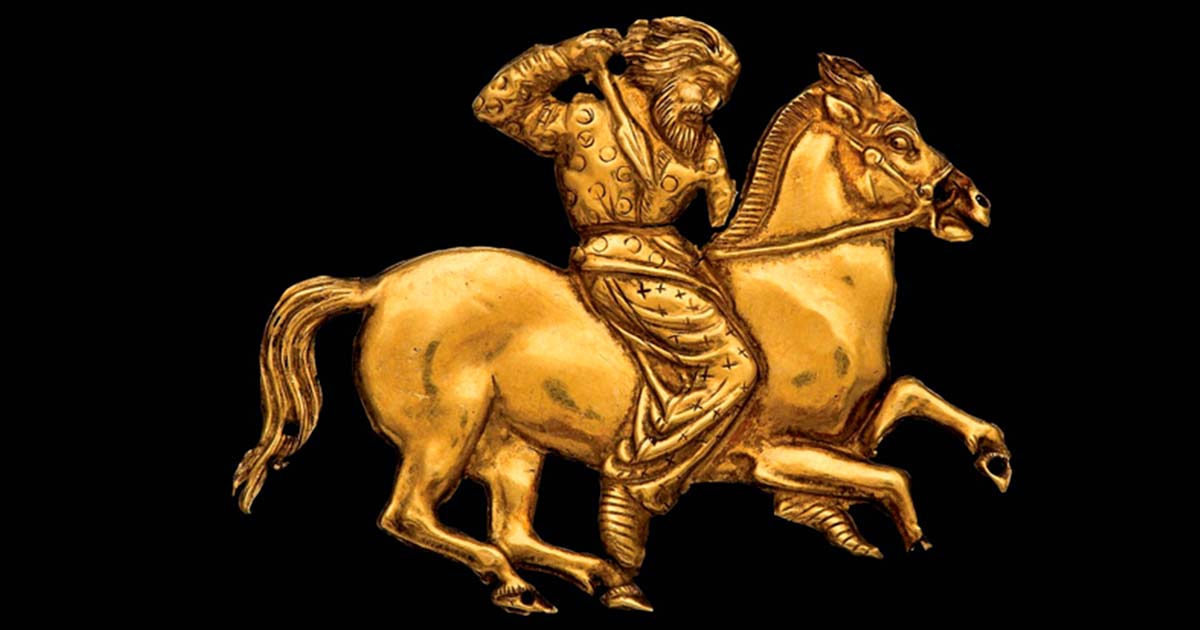Scythian Gold: The Rich Legacy of an Ancient Culture
Scythian gold is a treasure trove of ancient history and cultural heritage, shrouded in mystery and awe. This remarkable collection of gold artifacts, jewelry and other precious items stands for the wealth and skill of the ancient Scythian civilization, a nomadic people who dominated the steppes of Central Asia and Eastern Europe over two thousand years ago.
With its intricate designs, ornate decorations, and high level of artisanship, the Scythian gold supplies a glimpse into the artistic traditions and cultural beliefs of this fascinating ancient culture. Whether you are an archaeologist, historian, or simply a lover of all things gold, the Scythian gold is a must-see marvel that will leave you in awe and wonder.
Who Were the Scythians?
The Scythians were a nomadic people who lived in the steppes of Central Asia and Eastern Europe from the 9th century BC to the 4th century AD. They were horse-riding warriors and herders who roamed the vast grasslands of the steppes, building a powerful and influential civilization that lasted for over a thousand years.
- Golden Vessel Used In Scythian Drug-Fueled Rituals Is Expected to Sell for $57K At Auction
- A Warrior’s Face Frozen in Time, Gold, Hemp, Tents and Cheese Tell the Scythian Tale
The Scythians were known for their martial prowess and their skills in metalworking, particularly in the production of gold artifacts and jewelry. They had a rich cultural heritage, with a unique language, religion and mythology that was heavily influenced by their nomadic way of life.
Despite their powerful reputation, very little is known about the Scythians and their civilization, making the discovery of their gold artifacts and other cultural treasures all the more fascinating and valuable.

Historic illustration of a nomadic Scythian archer, a culture best known for its Scythian gold. (Lunstream / Adobe Stock)
Scythian Gold and the Culture of the Ancient Scythians
Much of what we know about the Scythians today has been revealed by what they left behind. Over the years, archaeologists have uncovered several Scythian archaeological sites and burial mounds that have given us a fascinating look into the lives of these nomadic people.
There tends to be a misconception that nomads were poor or lived simple and spartan lives. But what has been found shows the Scythians were anything but poor. They loved Scythian gold, and every facet of their lives was touched by it. Their clothing, religion and décor all seemingly revolved around the precious metal.
As nomads, the Scythians tended to move around a lot. As such, more Scythian decor was in plaque or applique style (which are easy to transport). This means that Scythian decor had a flat profile and was made in such a way that it could be attached or sewn to their horses’ tack or mounted on the walls of the Scythian's traditional house wagons.
Much of their decor was made of leather cutouts and felt applique. Examples of felt, leather and wood horse decorations have been found at the Bashadar and Pazyryk burial mounds in Mongolia’s Altai Mountains which date back to the late 6th to early 3rd centuries BC.
While these items were mainly made of leather it is interesting to note that most featured gold decorations. Many of the artifacts found at Bashadar and Pazyryk featured gold highlights. For example, one saddle hung four detachable leather cutouts of twisting fish which were decorated with gold touches.
Others were decorated with leather rosettes with spots of gold in their centers. It was also common for the Scythians to attach small gilded wooden plaques of eagles to both the bridles of their horses and chest straps.
Of course, this being the Scythians, solid gold ornaments were also popular. Some golden vessels found at the sites had engravings that depicted detailed hunting and warfare scenes. Thin golden plates which showed prey/predator scenes were also common.
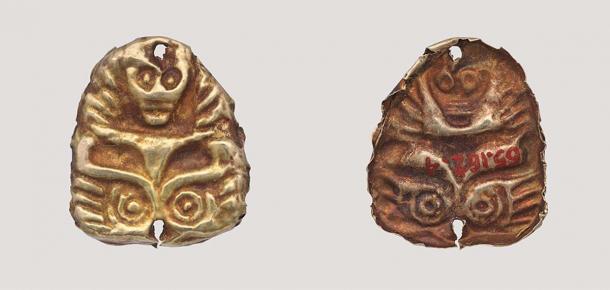
Front and back of an appliqué depicting a fantastic creature in Scythian gold. (Public domain)
Golden Fashion of the Scythians
It wasn’t just their décor that the Scythians liked to decorate with gold; they loved to wear it too. Unsurprisingly, gold was a common feature of Scythian fashion. One of the things the Scythians were most famous for was their unique form of headdress. These tall, pointed headdresses, described by Herodotus as “tall caps” may have looked odd, but they had a functional basis, protecting the head from evaporation.
As is common throughout history, what started as functional headwear became more elaborate over time, becoming taller and more heavily decorated. A prime example is the “Golden Man” found at the Issyk burial site near Lake Issyk. He was buried with a red pointed hat that was 65 cm (25 inches) high. As if its height alone wouldn’t make him stand out the hat was red and decorated with four miniature vertical spears and its base was adorned with impressive golden animals including snow leopards, winged tigers, and birds.
It was common for Scythians to have their clothing embroidered with gold, not just their headdresses. The more gold a person wore, the richer and therefore more powerful they were. This meant that golden clothing was the ultimate status symbol.
Unsurprisingly, this love of gold spread to Scythian jewelry. Many examples of Scythian necklaces, bracelets, earrings and diadems (a type of crown), many of which were adorned with intricate designs and symbols have been found. These symbols often had religious or cultural significance and could be used to identify the owner's status, social standing and ancestry.
What struck archaeologists most about these pieces when they were first unearthed, however, is how well-made and intricately designed they were. The craftsmanship displayed in the Synthian gold unearthed to date rivaled modern metallurgy in many ways.
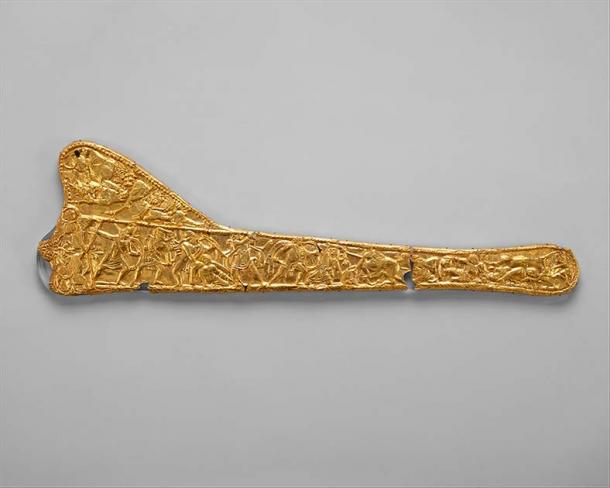
Sheet-gold decoration for a sword scabbard, believed to be Scythian gold and dated to circa 340 to 320 BC. (Public domain)
Scythian Metallurgy - Master Goldsmiths Ahead of Their Time
Scythian gold metallurgy was incredibly advanced for the time and the complex techniques their goldsmiths used were a testament to their high levels of skills and creativity. For example, Scythian goldsmiths used granulation. This was a technique that involved creating small granules of gold and fusing them to form delicate patterns and designs.
The granules were carefully placed on the surface of an object and then fused using carefully applied pressure and heat to create a uniform, seamless surface. The technique requires high levels of skill, precision and patience, as the beads had to be created to a consistent size and shape and then carefully arranged to form the desired pattern.
Scythian goldsmiths also used filigree. This involves using thin wires of gold to create delicate, lacy patterns and designs. The wires had to be carefully twisted and bent into intricate shapes which were then soldered onto the object's surface. Filigree is an incredibly difficult technique to master, requiring high levels of dexterity and precision to create intricate designs. Filigree is difficult with today's tools, but Scythian goldsmiths mastered it long ago.
Along with granulation and filigree, Scythian goldsmiths were masters of repousse. This is a metalworking technique that involves shaping metal from the reverse side, creating a raised design on the front. Scythian goldsmiths often used repousse to create intricate, three-dimensional designs on their artifacts.
The Scythian goldsmiths were also no strangers to more ordinary techniques, such as engraving. They would often use this technique to create fine details and intricate patterns, often scenes from their mythological beliefs and religious ceremonies. All of these techniques needed a high level of skill, patience and attention to detail, making Scythian goldsmiths some of the finest craftsmen of their time.
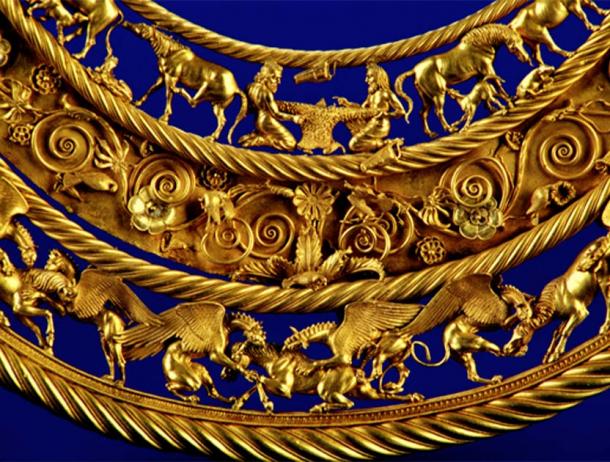
Scythian gold pectoral or neckpiece, dating back to the 4th century BC. (Free Art Licence)
The Quality and Aesthetics of Scythian Gold Artifacts
The techniques that the Scythian goldsmiths used created artifacts that were not just beautiful, they were highly functional, and many of them have withstood the test of time remarkably well, surviving to the present day in near-perfect condition.
The level of precision these techniques needed meant the Scythian goldsmiths needed specialized tools. For example, the kind of delicate hammers and punches they used to shape and mold the gold were masterpieces in their own right, far beyond the artisanship of many of their contemporaries.
It isn’t just the incredible artisanship and advanced metallurgy techniques which set the Scythian goldsmiths apart from their contemporaries. They had a distinctive design aesthetic, a blend of naturalism and stylization which was characterized by intricate and detailed depictions of natural and mythological scenes.
As nomads, the Scythians were close to nature and so their goldsmiths often incorporated elements from nature into their designs with animals, plants and flowers all being popular motifs. Their depictions of these animals were known for being incredibly precise and detailed but they were often enhanced by stylization, adding a unique twist to these depictions of the natural world.
Scythian goldsmiths also incorporated scenes from their mythological beliefs into their designs. The scenes in their gold work often depicted gods and goddesses as well as mythical creatures and they were often used to symbolize different aspects of Scythian culture and beliefs.
Where Did Scythians Get Their Gold?
With the amount of gold the Scythians were using, it seems fair to ask where they got it all from. As it turns out they got it from a variety of sources. For a start, a fair amount of the gold was likely obtained through trade with other cultures and civilizations.
The Scythians were part of a huge trade network that extended across much of the ancient world, and they likely traded goods and materials in exchange for gold. We know for a fact that the Scythians traded with the Greeks and Persians for example.
What they didn’t get from trading with others they found in their territory. Archaeological evidence suggests that the Scythians were able to extract gold from natural deposits found in rivers and streams as well as from alluvial deposits in nearby mountains. It has also been suggested that the Scythians may have extracted gold from ore deposits in the mountains using primitive mining techniques.
- Russian Soldiers Empty Ukraine Museum Of Scythian Artifacts
- Scythian Burial With Golden Headdress Found in Russia
Their final source of gold shouldn’t be surprising given their reputation as fierce warriors. It is likely that much of their gold came from their neighbors, but not as result of trade. Instead, historians believe that much Scythian gold found its way into their hands as a result of raids and conquests of neighboring territories.
Scythians believed that gold was a sign of wealth and power and so it is unsurprising that it played an important role in their religion. Scythian artifacts, with their intricate designs and ornate decorations, were considered to be worthy offerings to the gods. These golden offerings were believed to bring good fortune, protection and prosperity to the Scythian worshippers.
Gold was also seen as a great way to honor one's ancestors and the dead. Gold artifacts were often buried with the deceased as a way to ensure their status and wealth in the afterlife. It was common for wealthy Scythians to be buried with golden jewelry, clothing and even weapons.
Scythian religious rituals and festivals were also full of gold. Gold was used to decorate temples and symbolize the wealth and power of the Scythian people. Making donations of gold to the temple was a good way for the rich to not only secure their social standing but also their standing with the gods.
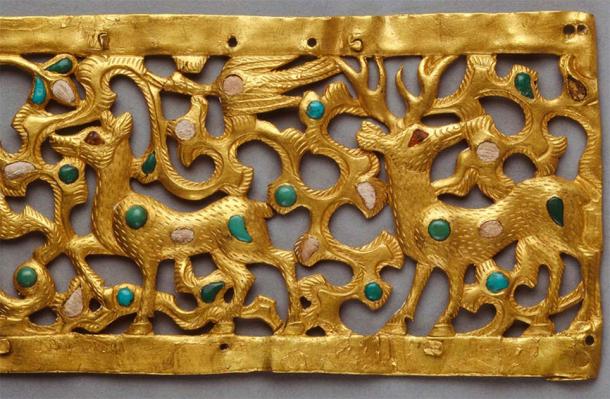
Detail of ancient Scythian gold artifact. (victor21041958 / Adobe Stock)
What Happened to the Scythians?
The exact fate of the Scythians is not clear, but it is believed that they were gradually assimilated into the neighboring civilizations and cultures over time. The Scythian empire was gradually weakened by internal conflicts and invasions from neighboring civilizations, such as the Persians and the Sarmatians.
One possible factor that may have contributed to the decline of the Scythians was the loss of control over their trade routes. The Scythians relied heavily on trade to acquire goods and resources, including gold, and the disruption of these trade routes may have hurt their economy. This being said, it does not appear that gold really played a part in the downfall of the Scythians. The Scythian downfall was the result of a steady decline caused by outside pressures.
By the 1st century AD, the Scythian civilization had declined, and their territories had been absorbed by neighboring civilizations. The Scythian language, culture and traditions were largely forgotten, and much of their heritage was lost to time.
Scythian gold is a remarkable testament to the wealth, skill and creativity of the ancient Scythian civilization. The intricate designs, innovative techniques and high level of artisanship displayed in these artifacts continue to inspire admiration and awe.
The objects found at Scythian dig sites serve as valuable historical artifacts, providing insight into the trade networks, cultural practices and religious beliefs of the ancient Scythian people. Although the Scythian civilization has long since vanished, their golden artifacts remain a symbol of their wealth, power and cultural heritage. Today, these artifacts continue to captivate audiences and give us a glimpse into the rich and fascinating history of the ancient world.
Top image: Scythian gold plaque depicting a Scythian rider with a spear. Source: Public domain
References
Cunliffe. B. 2019. The Scythians: Nomad Warriors of the Steppe. Oxford University Press
Jacobson. E. 1995. The Art of the Scythians. Brill.
Kuiper. K. 2018. “Scythian Art” in Encyclopedia Britannica. Available at: https://www.britannica.com/art/Scythian-art
Pankova. S; Simpson. J. 2021. Masters of the Steppe: The Impact of the Scythians and Later Nomad Societies of Eurasia: Proceedings of a conference held at the British Museum, 27-29 October 2017. Archaeopress Publishing Ltd
Smith. P. 2022. “Scythian Art” in World History Encyclopedia. Available at: https://www.worldhistory.org/Scythian_Art/
















